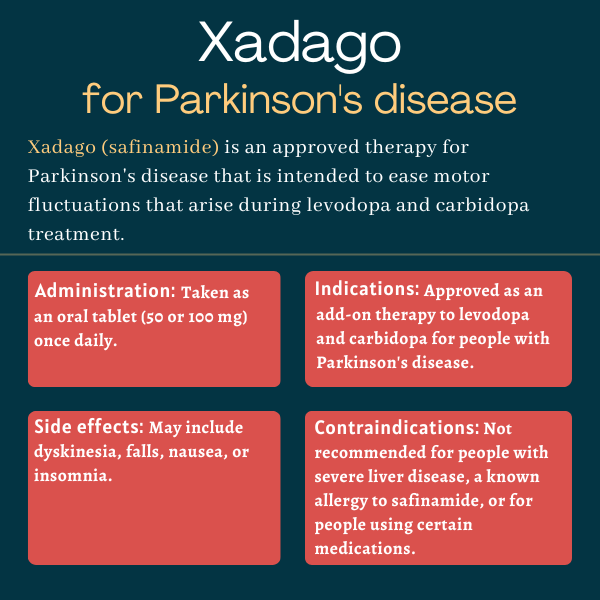Xadago (safinamide) for Parkinson’s disease
What is Xadago for Parkinson’s disease?
Xadago (safinamide) is an oral add-on (adjunctive) therapy used to manage off episodes, or motor fluctuations, in Parkinson’s disease patients being treated with levodopa and carbidopa.
Initially developed by Newron Pharmaceuticals, it is marketed by Supernus Pharmaceuticals in the U.S. In Europe, Xadago is marketed by Zambon and in Canada by Valeo Pharma.
Therapy snapshot
| Brand name: | Xadago |
| Chemical name: | safinamide |
| Usage: | Used to manage motor fluctuations in Parkinson’s disease patients on levodopa and carbidopa therapy. |
| Administration: | Oral tablets |
How does Xadago work?
In Parkinson’s disease, the progressive loss of nerve cells responsible for producing the signaling molecule dopamine leads to the disease’s hallmark motor symptoms. Patients are treated with levodopa and a compound like carbidopa, providing the brain with the precursors it needs to make more dopamine.
However, the medication’s effects can wear off between doses and motor symptoms return. These so-called off episodes, or motor fluctuations, may get longer over time. In addition, the higher doses of levodopa required as the disease progresses often result in uncontrolled involuntary movements, called dyskinesia.
Xadago is a highly selective, reversible inhibitor of monoamine oxidase B (MAO-B), an enzyme that normally works to break down dopamine. As such, Xadago is thought to help prevent the degradation of dopamine to ease motor fluctuations for Parkinson’s patients who are using levodopa and carbidopa.
The molecule also has been found to inhibit the release of glutamate, another brain signaling chemical that has been implicated in the motor and nonmotor symptoms of Parkinson’s.
However, the precise mechanism by which Xadago exerts its effects is not known, according to its developer.
Who can take Xadago?
Xadago was approved by the U.S. Food and Drug Administration (FDA) in March 2017 as an add-on therapy for people using levodopa and carbidopa. It was approved for use in the European Union in 2015 as an add-on therapy to levodopa, alone or in combination with other Parkinson’s medications.
Xadago is similarly approved in other countries, including Japan, Australia, and Canada.
Who should not take Xadago?
Xadago should not be used by people with a history of allergic reactions to safinamide, Xadago’s main ingredient, or those with severe liver impairments.
The therapy also should not be taken by people using any of the following medications:
- other monoamine oxidase (MAO) inhibitors or medications with MAO-inhibiting properties (e.g., linezolid)
- opioid medications (tramadol, meperidine, or related molecules)
- certain antidepressants
- cyclobenzaprine (a muscle relaxant)
- methylphenidate, amphetamine, or related derivatives
- St. John’s wort (a plant used for conditions such as depression, anxiety, attention-deficit hyperactivity disorder, or obsessive-compulsive disorder)
- dextromethorphan (a cough suppressant).
Patients should always inform their healthcare providers of all medications they are taking when deciding if Xadago is right for them.
How is Xadago administered in Parkinson’s?
Xadago is taken as a single oral tablet once daily. The starting dose is 50 mg daily, which may be increased to 100 mg after two weeks if symptoms are not adequately controlled and the therapy is tolerated.
Tablets are round, biconcave shaped, and orange-to-copper in color with a metallic gloss. They are embossed with a “50” on one side for 50 mg tablets, and “100” on one side for 100 mg tablets.
Tablets can be taken at any time of day, with or without food, but should be taken consistently at the same time each day. If a dose of Xadago is missed, the next dose should be taken at the same time the next day.
When stopping Xadago at the 100 mg dose, the dose should be tapered off, decreasing the dose to 50 mg for one week before stopping entirely.
For patients with moderate liver impairment, the maximum recommended dose of Xadago is 50 mg once daily. If a patient with moderate liver impairment develops severe liver impairment, Xadago use should be stopped.
Xadago has been shown to be effective only when used in combination with an established levodopa regimen.

Xadago in clinical trials
Xadago’s approval was supported by data from two Newron-sponsored Phase 3 trials, called Study 016 and SETTLE.
Study 016
This Phase 3 trial (NCT01187966) enrolled 669 adults with mid and late stage Parkinson’s and motor fluctuations, all on a stable dose of levodopa. They were randomly assigned to Xadago at a low dose (50 mg/day), high dose (100 mg/day), or to a placebo once daily for 24 weeks, or about six months.
Published results showed that the addition of Xadago at either dose significantly increased patients’ on-time, or periods of good motor symptom control, with no or non-troublesome dyskinesia, relative to placebo. It also significantly decreased off time and eased motor symptom severity, in addition to noted improvements in clinician-rated measures of symptom severity and patient-reported activities of daily living.
In a Phase 3 extension trial (NCT01286935), 544 patients continued with their assigned treatment in Study 016 for an additional 18 months, or 1.5 years. Increases in on time and reductions in off time observed in the main trial with Xadago’s use were maintained in this extension phase.
While the overall incidence of dyskinesia did not differ between the Xadago and placebo groups, treatment at the 100 mg dose was associated with a reduction in dyskinesia among patients with at least moderate dyskinesia at the study’s start.
Improvements in motor function, activities of daily living, mood, and quality of life that were observed in Study 016 at six months remained significant after two years of treatment.
SETTLE trial
The SETTLE Phase 3 study (NCT00627640) enrolled 549 advanced Parkinson’s disease patients who were experiencing more than 1.5 hours of off time each day while on a stable dose of oral levodopa plus carbidopa or benserazide.
Patients were randomized to receive Xadago (50 mg per day increased to 100 mg per day if tolerated) or a placebo for 24 weeks.
Results showed that daily on time without troublesome dyskinesia significantly increased with the addition of Xadago relative to a placebo. The therapy also was associated with significant decreases in daily off time, better motor function, and life quality gains.
Pooled analyses from Study 016 and SETTLE also indicated that Xadago might help to ease pain, a frequent nonmotor symptom of Parkinson’s.
MOTION trial
Further supporting evidence came through the Phase 3 MOTION study (NCT00605683) involving 679 early Parkinson’s patients, partly defined as a disease duration of less than five years, who were on stable therapy with a single dopamine agonist, or medications that stimulate dopamine signaling.
These adults were randomly assigned to Xadago at a 100 mg or 200 mg daily dose, or to a placebo for 24 weeks. Results indicated that Xadago at the 100 mg, but not the 200 mg, daily dose led to significant improvements in motor function relative to placebo.
Common side effects of Xadago
The most common side effects associated with Xadago include:
- dyskinesia (uncontrolled, involuntary movements)
- falls
- nausea
- insomnia (trouble sleeping)
High blood pressure
Xadago may cause high blood pressure or exacerbate existing hypertension. Patients’ blood pressure should be monitored while using Xadago, and medication adjustments may be necessary in cases of sustained hypertension.
Xadago should not be used at doses higher than the recommended daily dose, and it should not be taken with other MAO inhibitors. This combination can cause hypertension, including the risk of a life-threatening hypertensive crisis.
Taking Xadago with certain foods that have very high amounts of tyramine, an amino acid that regulates blood pressure and which is broken down by MAO, may cause severe hypertension. These foods, which typically include aged, fermented, cured, smoked, or pickled foods, should be avoided when taking Xadago.
Patients using certain other medications should be closely monitored for hypertension. This includes isoniazid, a medication used to treat or prevent tuberculosis, as well as prescription or nonprescription nasal, oral, or eye decongestants and cold remedies.
Serotonin syndrome
For patients using other MAO inhibitors, certain antidepressants, or opioid medications, Xadago may cause serotonin syndrome, a life-threatening side effect marked by high levels of serotonin, a brain signaling chemical. Symptoms can include changes in mental state, neuromuscular symptoms, seizures, gastrointestinal issues, or changes in heart rate, blood pressure, or body temperature.
As such, Xadago should not be taken by patients using any of these medications.
Daytime sleepiness
Patients treated with dopamine-enhancing medications like Xadago have reported suddenly falling asleep, and this can occur during daily activities requiring attention, such as driving, talking, and eating. In most cases of sudden onset sleepiness, Xadago should be discontinued. Patients who continue on treatment should avoid driving or other potentially dangerous activities.
Dyskinesia
Patients on Xadago may experience an onset or worsening of dyskinesia. Levodopa dose reductions should be considered if this occurs.
Hallucinations or psychosis
An increase in dopamine signaling can risk symptoms of psychosis, including hallucinations — experiencing things that are not there — and delusions, or beliefs not based in reality.
As such, Xadago may exacerbate psychosis in patients with an existing major psychotic disorder, and it typically is not recommended for them. A dose reduction or treatment stop may be considered if patients develop hallucinations or other psychotic behaviors while using Xadago.
Xadago should not be taken with dextromethorphan, a common ingredient in cough medicines. This combination has been reported to cause episodes of psychosis or abnormal behavior.
Impulse control issues
Increases in dopamine with Xadago or similar treatments also may lead to problems with impulse control, including difficulty controlling urges to gamble, show sexual behaviors, spend money, or engage in binge eating.
Because patients may not recognize such behaviors as unusual, doctors should ask patients or caregivers specifically about them. A dose reduction or stopping treatment altogether may be considered if such control issues are evident.
Withdrawal-emergent fever and confusion
Suddenly stopping or reducing the dose of Xadago could lead to symptoms resembling neuroleptic malignant syndrome, characterized by high fever, muscle rigidity, altered consciousness, and changes in other involuntary bodily processes (e.g., blood pressure and heart rate).
When stopping Xadago at the 100 mg dose, it is recommended that the dose first be lowered to 50 mg daily for one week.
Eye issues
Degeneration of the eye’s retina — the tissue at the back of the eye that sends visual information to the brain — was reported in animal studies of Xadago. Patients with eye diseases or a family history of them should be monitored for visual changes while using Xadago.
Pregnancy and breastfeeding
Data is lacking on the use of Xadago in women who are pregnant, but animal studies indicate that the therapy may harm a developing fetus. Women who are pregnant or wish to become pregnant while using Xadago should discuss the matter with their healthcare team.
Likewise, no studies have looked into whether Xadago passes into human breast milk. The benefits of breastfeeding should be considered along with the mother’s need for Xadago and potential risks to the breastfed infant.
Parkinson’s News Today is strictly a news and information website about the disease. It does not provide medical advice, diagnosis or treatment. This content is not intended to be a substitute for professional medical advice, diagnosis, or treatment. Always seek the advice of your physician or another qualified health provider with any questions you may have regarding a medical condition. Never disregard professional medical advice or delay in seeking it because of something you have read on this website.
Recent Posts
- Understanding the importance of advance directives
- New study reveals why exercise is vital for Parkinson’s brain health
- GT-02287 boosts enzyme activity in Parkinson’s brain: Trial data
- Dealing with scrutiny when symptoms of Parkinson’s are invisible
- Grant backs new imaging approach for earlier Parkinson’s detection
Related articles

 Fact-checked by
Fact-checked by 




